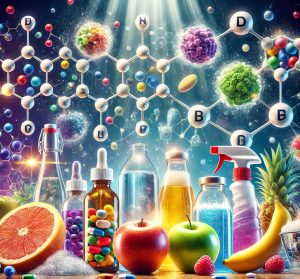Colloids and emulsions are types of mixtures that play important roles in various scientific fields, from chemistry and biology to material science and industry. These mixtures have unique properties that make them valuable in applications ranging from food production to pharmaceuticals, cosmetics, and environmental science. This explanation will cover the fundamental concepts of colloids and emulsions, their properties, classifications, mechanisms of stability, applications, and more.
1. Introduction to Colloids
A colloid is a heterogeneous mixture where one substance (the dispersed phase) is finely divided and uniformly distributed in another substance (the continuous phase) without dissolving in it. The particles in a colloid are larger than those in a true solution but small enough to remain dispersed without settling out. Colloids are found everywhere, including in food, biological fluids, and various products. Their unique properties stem from the interaction between the dispersed particles and the continuous medium.
Characteristics of Colloids
- Particle Size: Colloidal particles typically range from 1 nanometer to 1 micrometer (10⁻⁹ to 10⁻⁶ meters). This size range makes them large enough to scatter light (Tyndall effect) but small enough to remain dispersed.
- Heterogeneity: Colloids are heterogeneous at the microscopic level, even though they may appear homogeneous to the naked eye.
- Stability: Colloidal particles do not settle out under normal gravitational forces due to Brownian motion (the constant, random movement of particles).
- Scattering of Light: Colloidal particles scatter light, producing phenomena such as the Tyndall effect, which can help identify colloidal systems.
2. Types of Colloids
Colloids are classified based on the physical states of the dispersed and continuous phases. These classifications include:
- Aerosols: Colloids with gas as the continuous phase. Examples include fog (liquid in gas) and smoke (solid in gas).
- Foams: Systems where gas is dispersed in a liquid or solid. Examples include whipped cream (gas in liquid) and foam rubber (gas in solid).
- Emulsions: Colloids in which both dispersed and continuous phases are liquids. Examples include milk and mayonnaise.
- Gels: Systems with a solid network that traps a liquid, creating a semi-solid structure, such as in gelatin and jelly.
- Sols: Colloids where solid particles are dispersed in a liquid or another solid. Examples include ink (solid in liquid) and stained glass (solid in solid).
3. Emulsions: A Special Type of Colloid
An emulsion is a specific type of colloid where both the dispersed phase and the continuous phase are liquids that do not naturally mix. Emulsions are formed by dispersing droplets of one liquid into another immiscible liquid, with the help of energy input (e.g., shaking or mixing) and stabilizers known as emulsifiers.
Types of Emulsions
- Oil-in-Water (O/W): In an oil-in-water emulsion, oil droplets are dispersed in a water-based continuous phase. Examples include milk, mayonnaise, and lotions.
- Water-in-Oil (W/O): In this emulsion, water droplets are dispersed in an oil-based continuous phase. Examples include butter and certain creams.
- Multiple Emulsions: These are more complex emulsions where an emulsion is dispersed within another emulsion, such as water-in-oil-in-water (W/O/W) or oil-in-water-in-oil (O/W/O). Multiple emulsions are used in drug delivery and advanced cosmetic formulations.
Characteristics of Emulsions
- Stability: Emulsions are inherently unstable and tend to separate over time due to coalescence or flocculation. Emulsifiers, such as surfactants, are often added to improve stability.
- Droplet Size: The size of droplets in an emulsion ranges from 100 nanometers to several micrometers, affecting texture, appearance, and stability.
- Appearance: Emulsions can be opaque, translucent, or transparent, depending on droplet size and concentration.
4. Formation and Stability of Colloids and Emulsions
Formation of Colloids
Colloids can form naturally or be created through mechanical or chemical methods:
- Mechanical Dispersion: Colloids can be produced by dispersing particles in a medium through stirring, grinding, or sonication (ultrasonic waves).
- Condensation: This involves the aggregation of small molecules into larger colloidal particles, as seen in the formation of fog (water droplets condensing in the air).
Formation of Emulsions
Emulsions require the application of energy to disperse one liquid in another, usually with the help of an emulsifier. Emulsifiers are surface-active agents (surfactants) that reduce interfacial tension between the two immiscible liquids. Emulsifiers are typically amphiphilic, meaning they have both hydrophilic (water-attracting) and hydrophobic (oil-attracting) parts. They stabilize emulsions by forming a protective layer around droplets, preventing them from coalescing.
5. Stability Mechanisms in Colloids and Emulsions
Maintaining stability is crucial for the functionality and shelf-life of colloidal and emulsion systems.
Stabilization in Colloids
Colloidal stability is achieved through:
- Electrostatic Repulsion: Charged colloidal particles repel each other, preventing aggregation.
- Steric Stabilization: Large molecules or polymers adsorb onto the surface of colloidal particles, creating a physical barrier that prevents them from coming close.
- Hydration: In aqueous colloids, water molecules can form a hydration layer around particles, keeping them separated.
Stabilization in Emulsions
Emulsions are stabilized through:
- Surfactants (Emulsifiers): Emulsifiers form a protective layer around droplets, reducing interfacial tension and preventing coalescence.
- Viscosity Modifiers: Increasing the viscosity of the continuous phase (e.g., adding thickening agents) slows down the movement of droplets, reducing the rate of separation.
- Droplet Size Control: Smaller droplets create a more stable emulsion due to increased surface area and reduced buoyancy effects.
6. Properties of Colloids and Emulsions
Optical Properties
- Tyndall Effect: Colloids scatter light due to their particle size, resulting in an effect known as the Tyndall effect, where light passing through the colloid becomes visible as a beam.
- Opacity: The opacity of colloids and emulsions depends on particle or droplet size and concentration. Emulsions with larger droplets appear more opaque.
Kinetic Properties
- Brownian Motion: Colloidal particles exhibit constant, random motion, which helps prevent settling and maintain stability.
- Diffusion: Colloidal particles diffuse through the medium, and their diffusion rate depends on particle size and temperature.
Rheological Properties
- Viscosity: Colloids and emulsions often exhibit unique viscosity behaviors. For example, emulsions can display shear-thinning behavior, where viscosity decreases with applied force, as in mayonnaise.
- Thixotropy: Some colloidal systems, like gels, are thixotropic, meaning they become less viscous when stirred or shaken and return to their original viscosity when left undisturbed.
7. Applications of Colloids and Emulsions
Food Industry
- Colloids: Foods like milk, cheese, and sauces are colloidal in nature. These products rely on colloidal stability for texture and consistency.
- Emulsions: Emulsions are used in products like salad dressings, ice cream, and mayonnaise. The stability and texture of these products depend on emulsifiers to maintain the dispersion of oil and water phases.
Pharmaceuticals and Medicine
- Drug Delivery: Colloidal particles, such as liposomes and nanoparticles, are used to deliver drugs, allowing for controlled release and targeted delivery.
- Emulsions in Medicine: Emulsions, such as intravenous lipid emulsions, are used to deliver fat-soluble nutrients to patients. Emulsion stability is crucial to prevent phase separation and ensure safe administration.
Cosmetics
- Emulsions: Many skincare and cosmetic products are emulsions (e.g., creams, lotions) that require emulsifiers for stability and smooth texture.
- Nanocolloids: Nanosized colloids are used in sunscreens and anti-aging products for better skin penetration and efficacy.
Industrial Applications
- Paints and Coatings: Emulsions and colloidal suspensions are used in paints, varnishes, and coatings, where stability and particle distribution are essential for even application and durability.
- Mining and Oil Recovery: Colloids are used in mineral processing and enhanced oil recovery to improve extraction efficiency by altering the properties of oil and water interfaces.
Environmental Applications
- Water Purification: Colloids are used in water treatment processes, such as flocculation and coagulation, to remove impurities.
- Remediation of Pollutants: Colloidal particles, especially nanocolloids, are employed to capture or degrade environmental pollutants, including heavy metals and organic contaminants.
Challenges in Colloids and Emulsions
Despite the wide range of applications and the many advantages that colloids and emulsions offer in industries such as food, pharmaceuticals, cosmetics, and environmental sciences, there are several challenges that must be addressed in their preparation, stability, and use. These challenges arise due to the delicate balance between the dispersed phase (e.g., particles or droplets) and the continuous phase, the need for specific stabilizers, and the complexity of ensuring consistent properties in large-scale applications. Below are the major challenges in colloids and emulsions:
1. Stability Issues
Instability and Separation:
- Coalescence: In emulsions, especially oil-in-water (O/W) or water-in-oil (W/O) emulsions, droplets of the dispersed phase can merge or “coalesce” over time, leading to phase separation. This is a significant problem in the food and pharmaceutical industries, where consistency in product texture and appearance is essential.
- Flocculation: This refers to the aggregation of particles in a colloidal suspension. The particles may come together and form clusters, making the colloid unstable. Flocculation can happen when the particles in a colloidal system have attractive forces that bring them together.
- Sedimentation: Colloidal particles are typically small enough to remain suspended in the continuous phase due to Brownian motion, but over time, they may settle if their density is much greater than that of the medium, or if there is not enough energy to keep them dispersed.
Phase Separation in Emulsions:
- In emulsions, the dispersed phase (e.g., oil droplets) can separate from the continuous phase (e.g., water) due to gravitational forces, especially when the difference in densities between the phases is significant. The separation leads to the breakdown of the emulsion and compromises the product’s quality.
- Ostwald Ripening: In emulsions, small droplets can migrate toward larger ones, causing a loss in the uniformity of the droplet size distribution. The process occurs because smaller droplets have a higher surface area-to-volume ratio and therefore tend to dissolve in the continuous phase, re-depositing on the larger droplets.
Solutions:
- Use of Stabilizers/Emulsifiers: The addition of surfactants, polymers, or other stabilizers helps to reduce the tendency for coalescence, flocculation, and phase separation. These substances lower the interfacial tension between the phases, improving the stability of the emulsion or colloid.
- Controlled Processing Conditions: Factors like temperature, pressure, and shear rate during emulsification or colloid preparation need to be optimized to achieve the desired stability. For example, homogenization techniques can be used to create smaller, more stable droplets.
2. Viscosity and Rheological Challenges
Viscosity Control in Colloidal Suspensions:
- The viscosity of colloidal suspensions can affect their flow behavior and processability. High viscosity is often desirable for maintaining the dispersion of particles, especially in industrial applications like paints, coatings, and food products. However, excessive viscosity can complicate the mixing, transport, or spraying processes.
Shear Thinning vs. Shear Thickening:
- Shear-thinning behavior occurs when the viscosity of a colloidal system decreases as shear stress (such as stirring or shaking) is applied. This is typical in many food products and cosmetics, where the product needs to flow easily under stress but remain thick and stable when at rest.
- Shear-thickening occurs in some colloidal systems where viscosity increases under stress. This behavior can be problematic in systems like paints, where uniform application is difficult if viscosity increases unexpectedly under shear.
Rheological Properties of Emulsions:
- Emulsions, particularly those used in food and cosmetics, must maintain specific rheological properties (flow and deformation characteristics) to ensure ease of application and desirable texture. For example, lotions must have an appropriate level of spreadability and thickness, while food emulsions must exhibit proper mouthfeel.
- Non-Newtonian Behavior: Many colloidal systems, including emulsions, exhibit non-Newtonian behavior, meaning their viscosity does not follow a simple relationship with shear rate. This complicates processing, formulation, and quality control.
Solutions:
- Addition of Thickeners or Gums: Polymers like guar gum or xanthan gum can be added to increase viscosity and stabilize colloids or emulsions.
- Optimizing Shear Conditions: Controlling the shear rate during emulsification can reduce shear-thinning or shear-thickening effects, producing more stable products.
- Formulation Tweaks: Small adjustments to the concentration of dispersed phase or emulsifiers can fine-tune the viscosity and improve the end-product’s texture.
3. Emulsifier and Surfactant Limitations
Selection of Appropriate Emulsifiers:
- Emulsifiers are surfactants that lower the surface tension between the oil and water phases, enabling the formation of stable emulsions. The type and concentration of emulsifier used are critical in determining the stability and texture of the emulsion.
- Compatibility: Many emulsifiers are specific to certain types of emulsions (e.g., oil-in-water vs. water-in-oil). Finding the right emulsifier for a given system can be challenging and requires a good understanding of the system’s chemistry.
- Toxicity and Sensitivity: Some emulsifiers used in food, cosmetic, and pharmaceutical products may pose health risks or lead to allergic reactions in sensitive individuals. This raises concerns about the widespread use of emulsifiers, especially in consumer products.
Solutions:
- Development of New Emulsifiers: Ongoing research is focused on developing new, biocompatible, and non-toxic emulsifiers that can work in a variety of applications. These may be derived from natural sources such as plant oils or proteins.
- Biodegradable and Non-toxic Surfactants: The development of environmentally friendly emulsifiers is an area of focus, as there is increasing consumer and regulatory demand for sustainable products.
4. Scale-Up Challenges
Scaling up the production of colloids and emulsions from the laboratory to industrial levels presents numerous challenges. In small-scale systems, the conditions such as temperature, pressure, and mixing speed can be easily controlled. However, when moving to large-scale production, several issues arise:
- Homogeneity: In large-scale emulsions or colloidal suspensions, achieving a uniform particle or droplet size distribution becomes difficult. Any variation in size can lead to instability or poor performance in the final product.
- Energy Requirements: Large-scale emulsification requires substantial energy input to break down the droplets to the desired size. Energy-efficient technologies must be developed to minimize operational costs and environmental impact.
- Material Handling: The scale-up process may require the handling of large quantities of raw materials, which can introduce variability in the system, particularly in ensuring the proper concentration of stabilizers or emulsifiers.
Solutions:
- Continuous Processing: In some industries, continuous processing techniques have been developed to ensure the production of stable emulsions and colloidal systems. This method allows for the constant mixing and dispersing of phases without losing uniformity.
- Optimization of Mixing Equipment: High-shear mixers, homogenizers, and ultrasound technology are often employed for large-scale emulsification to achieve finer and more stable emulsions.
- Automation and Control: Advances in automation and process control systems enable better monitoring and regulation of production parameters to ensure consistency in large-scale manufacturing.
5. Environmental and Regulatory Concerns
Environmental Impact of Colloidal and Emulsion-based Products:
- The production of colloids and emulsions, especially those involving synthetic chemicals, may result in significant environmental impacts, including pollution and resource depletion. The use of non-renewable resources and the creation of waste products during the production process are areas of concern.
Regulatory Compliance:
- Colloidal and emulsion-based products are subject to strict regulatory frameworks in many industries, especially in food, cosmetics, and pharmaceuticals. The selection of ingredients, such as emulsifiers, surfactants, and stabilizers, must meet the safety and toxicity standards established by regulatory agencies like the U.S. Food and Drug Administration (FDA) or the European Medicines Agency (EMA).
- Sustainability: The drive for sustainability is a significant challenge in the formulation and production of emulsions and colloidal systems. Manufacturers are under increasing pressure to use biodegradable and eco-friendly ingredients, reduce waste, and minimize energy consumption in the production process.
Solutions:
- Green Chemistry Approaches: The field of green chemistry is working toward more sustainable methods of producing colloids and emulsions, such as using natural, renewable ingredients and minimizing toxic byproducts.
- Recycling and Waste Management: In large-scale production, efforts can be made to recycle water and reduce waste, ensuring a more environmentally responsible process.
- Strict Quality Control: To ensure regulatory compliance, thorough testing and quality control measures must be implemented at every stage of production.
10 common questions with detailed answers explaining colloids and emulsions:
1. What is a colloid?
A colloid is a mixture in which one substance is dispersed in another, but the dispersed particles are too small to be seen with the naked eye. Colloidal particles are between 1 nm to 1 µm in size. They are not dissolved in the medium but remain suspended due to Brownian motion. Colloids are heterogeneous at the microscopic level but can appear homogeneous at the macroscopic level. Common examples include milk, fog, and paints.
2. What is an emulsion?
An emulsion is a specific type of colloid where two immiscible liquids are mixed together, one being dispersed as tiny droplets in the other. Emulsions typically require the use of an emulsifier, which helps stabilize the system. The two types of emulsions are oil-in-water (O/W) and water-in-oil (W/O). Examples of emulsions include mayonnaise (oil in water) and butter (water in oil).
3. What are the different types of colloids?
Colloids can be classified based on the physical states of the dispersed phase and continuous phase:
- Aerosols: Solid or liquid particles dispersed in a gas (e.g., fog, smoke).
- Foams: Gas dispersed in a liquid or solid (e.g., whipped cream, foam rubber).
- Sols: Solid particles dispersed in a liquid (e.g., ink, paint).
- Gels: A liquid dispersed in a solid, forming a semi-solid structure (e.g., jelly, gelatin).
- Emulsions: Liquid droplets dispersed in another liquid (e.g., milk, mayonnaise).
4. How are colloids and emulsions formed?
- Colloids can be formed through mechanical dispersion (e.g., grinding, stirring) or condensation (e.g., cooling a saturated solution or evaporating solvent).
- Emulsions are typically formed by mixing two immiscible liquids with the aid of an emulsifier, which reduces the surface tension between the phases, and mechanical energy is applied (e.g., shaking, blending) to break the droplets into a stable size range.
5. What are the stability issues faced by colloids and emulsions?
Colloids and emulsions face stability issues such as:
- Coalescence: In emulsions, droplets can merge, leading to separation of the phases.
- Sedimentation: In colloids, particles may settle under gravity.
- Flocculation: Particles aggregate due to weak attractive forces.
- Ostwald Ripening: Small droplets in emulsions dissolve and redeposit onto larger droplets, causing instability.
To overcome these issues, stabilizers like emulsifiers or polymers are added, and energy input is used to prevent separation.
6. What is the role of an emulsifier in emulsions?
An emulsifier is a substance that stabilizes an emulsion by reducing the interfacial tension between the dispersed and continuous phases. Emulsifiers have an amphiphilic structure, meaning they have both hydrophilic (water-attracting) and hydrophobic (oil-attracting) parts. The hydrophobic part binds with oil droplets, while the hydrophilic part interacts with the water phase, keeping the droplets dispersed and preventing coalescence. Common emulsifiers include lecithin in egg yolk and soap molecules.
7. What is the Tyndall effect in colloids?
The Tyndall effect is the scattering of light by colloidal particles. When a beam of light passes through a colloidal system, the particles scatter the light, making the beam visible. This effect is used to distinguish colloidal solutions from true solutions, as true solutions do not scatter light. The Tyndall effect is commonly observed in fog or milk.
8. How are colloids and emulsions used in the food industry?
- Colloids: Many food products are colloidal, such as soups, sauces, and salad dressings. These foods depend on the uniform dispersion of ingredients like oils, proteins, and starches. The texture and stability of these products rely on the properties of colloids.
- Emulsions: Emulsions are widely used in food products like mayonnaise, ice cream, and margarine, where the stable dispersion of oil droplets in water-based systems is crucial for consistency and mouthfeel. Emulsifiers like egg yolk or mustard are commonly used to stabilize these emulsions.
9. What are the challenges in scaling up the production of colloids and emulsions?
Scaling up colloid and emulsion production from laboratory to industrial scale presents several challenges:
- Homogeneity: Achieving uniform particle size distribution and consistent stability in large batches can be difficult.
- Energy Requirements: High energy inputs are often needed to break down the dispersed phase into smaller particles or droplets, which can be expensive.
- Shear Sensitivity: Some colloidal and emulsion systems are sensitive to shear forces (e.g., breaking droplets or altering viscosity), requiring careful handling during processing.
10. What is the future of colloids and emulsions in industry?
The future of colloids and emulsions lies in:
- Nanotechnology: Nanocolloids are being developed for more efficient drug delivery systems, improved coatings, and high-performance materials.
- Sustainability: There is a growing focus on developing eco-friendly emulsifiers and stabilizers from renewable sources to reduce the environmental impact.
- Smart Emulsions: Research is ongoing to create stimuli-responsive emulsions that can change properties (e.g., viscosity, stability) based on environmental conditions, such as pH or temperature.
Colloids and emulsions continue to have significant potential in many industries, including food, medicine, cosmetics, and environmental applications, offering innovative solutions to a range of problems.






